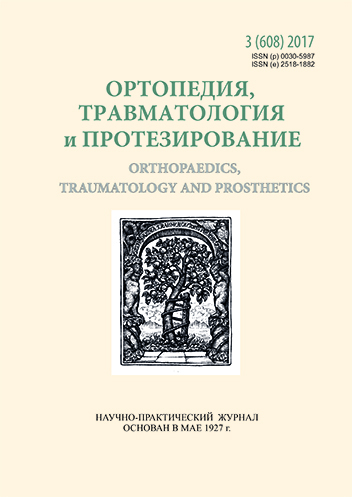Some biomechanical features of medialization of the pressed and screwed-in cups in total hip arthroplasty in patients with dysplastic coxarthrosis
DOI:
https://doi.org/10.15674/0030-59872017326-31Keywords:
dysplastic coxarthrosis, total joint replacement, hip component, mediallization, cotyloplastyAbstract
After total joint replacement in patients with dysplastic coxarthrosis, a significant number of negative results are observed. One of the ways of solving the problem of primary stability of the endoprosthetic cup is its mediation by deepening the acetabulum in the zone of its a natomical center.
Objective: top erform a comparative biomechanical evaluation of the stability of the cups that are fastened and screwed up, in the event of their mediation performed under the conditions of joint replacement in patients with dysplastic coxarthrosis.
Methods: with the help of mathematical modeling, the relatively strong characteristics of the pelvic bone in the area of the acetabulum and the quality of fixation of cup and cup after their mediation and immersion in the zone of the anatomical center of the depression. The total displacement of the head of the femoral component of the implant is analyzed.
Results: it was found that using scintillating cup under the condition of dysplastic coxarthrosis provides total displacement in (2.2 ÷ 2.4) times greater than in the situations of its application without defect of the acetabulum. When the cup is pressed, the total displacement is 4.7 times larger than the screw cup. In these cases, hip replacement with the use of pressed cups is accompanied by a high risk of their primary instability.
Conclusions: the use of screw-in cups in the case of their mediation under the conditions of total joint replacement in patients with dysplastic coxarthrosis provides a more reliable primary stability than the ones pushed into cups. The level of tension in the pelvic bone of the acetabulum is influenced by the depth of the cup setting, with the increase of which there is a significant destruction of bone tissue. It is advisable to carry out the hip joint replacement in the case of dysplastic coxarthrosis using a screw-in cup.References
- Hess WE, Umber JS. Total hip arthroplasty in chronically dislocated hips: follow-up study on the protrusio socket techniques. J Bone Joint Surg Am. 1978 Oct;60(7):948-54.
- Karachalios Th, Rodis N, Lampropoulou-Adamidou K, Hartofilakidis G. Acetabular reconstruction in patients with low and high dislocation. 20- to 30-year survival of an impaction grafting technique (named cotyloplasty). J Bone Joint J. 2013;95-B:887-92. doi: 10.1302/0301-620X.95B7.31216.
- Lieberman JR. Hybrid and cementless total hip replacement in patients younger than fifty years of age were similar after eighteen years. J Bone Joint Surg Am. 2011;93-A(22):2123-9. doi: 10.2106/ JBJS.9322.ebo191.
- Krych AJ, Howard JL, Trousdale RT, Cabanela ME, Berry DJ. Total hip arthroplasty with shortening subtrochanteric osteotomy in Crowe type 4 developmental dysplasia. J. Bone Joint Surg Am. 2010 Sep;92 Suppl 1 Pt 2:176-87. doi: 10.2106/JBJS.J.00061.
- Krych AJ, Howard JL, Trousdale RT, Cabanela ME, Berry DJ. Total hip arthroplasty with shortening subtrochanteric osteotomy in Growe type IV developmental dysplasia: surgical technique. J Bone Joint Surg Am. 2010 Sep;92 Suppl 1 Pt 2:176-87. doi: 10.2106/JBJS.J.00061.
- Nawabi D, Meftah M, Nam D, Ranawat AS, et al. Uncemented total hip arthroplasty for Growe II/III dysplasia using a high hip center without bone graft. AAOS 2013 Annual Meeting. Abstract of Podium Presentation. 2013. pp.379-80.
- Philippenko VA, Korzh NA. Total hip replacement. Kharkov: Kollegium, 2015. 219 p.
- Hartofilakidis G, Karachalios T. Total hip arthroplasty for congenital hip disease. J Bone Joint Surg Am. 2004 Feb;86-A(2):242-50.
- Li H, Mao Y, Oni JK, Dai K, Zhu Z. Total hip replacement for developmental dysplasia of the hip with more than 30% lateral uncoverage of uncemented acetabular components. J Bone Joint Surg. 2013 Sep;95-B(9):1178-83. doi: 10.1302/0301-620X.95B9.31398.
- Miteleva ZM, Organov VV, Chuyko AN, Bansal A. Role of acetabular subchondral layer during total hip replacement. Orthopaedics, Traumatology and Prosthetics.1999;(1):33-7.
- Loskutov OA. Biomechanical rationale for acetubalar component selection for total hip replacement in patients with dysplastic coxarthrosis. Orthopaedics, Traumatology and Prosthetics. 2017;(2):14-22. doi: 10.15674/0030-59872017214-22.
Downloads
How to Cite
Issue
Section
License
Copyright (c) 2017 Oleg Loskutov

This work is licensed under a Creative Commons Attribution 4.0 International License.
The authors retain the right of authorship of their manuscript and pass the journal the right of the first publication of this article, which automatically become available from the date of publication under the terms of Creative Commons Attribution License, which allows others to freely distribute the published manuscript with mandatory linking to authors of the original research and the first publication of this one in this journal.
Authors have the right to enter into a separate supplemental agreement on the additional non-exclusive distribution of manuscript in the form in which it was published by the journal (i.e. to put work in electronic storage of an institution or publish as a part of the book) while maintaining the reference to the first publication of the manuscript in this journal.
The editorial policy of the journal allows authors and encourages manuscript accommodation online (i.e. in storage of an institution or on the personal websites) as before submission of the manuscript to the editorial office, and during its editorial processing because it contributes to productive scientific discussion and positively affects the efficiency and dynamics of the published manuscript citation (see The Effect of Open Access).














